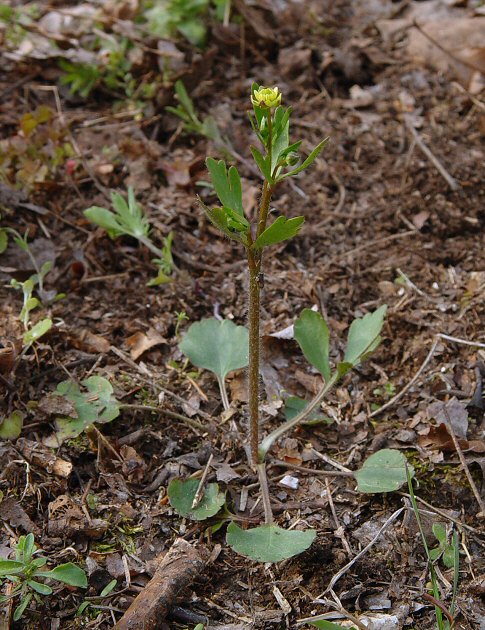Ranunculus micranthus Nutt.
Rock Buttercup

Native
CC = 3
CW = 3
MOC = 63
© DETenaglia
Ranunculus micranthus Nutt.Rock Buttercup | |
 |
Native CC = 3 CW = 3 MOC = 63 |
© DETenaglia |
|
Family - Ranunculaceae Habit - Biennial or short-lived perennial forb with tuberous-thickened roots. Stems - Ascending to erect, to 50 cm, sparsely to moderately pubescent with spreading hairs (more densely so toward the base), simple or branching, single or multiple from the base.
Leaves - Basal and alternate. Basal leaves with petiole to 8 cm long, the blade 1.0-3.3 cm long, 1-3 cm wide, broadly elliptic to broadly ovate or more or less circular, simple or compound, unlobed or sometimes the innermost 3-lobed or with 3 leaflets, the base truncate to broadly angled or sometimes shallowly cordate, the margins otherwise finely to coarsely scalloped. Stem leaves sessile to short-petiolate, the blade deeply 3-lobed or compound with 3 leaflets, the segments narrowly lanceolate to obovate, the broader ones toothed or narrowly lobed along the margins.
Inflorescence - Terminal single flowers on long peduncles. Peduncles sparsely to densely hairy, to 5-6 cm long but typically less.
Flowers - Sepals 5, 2-4 mm long, spreading or reflexed from the base with age (lacking a transverse fold or joint), plane. Petals 5, 1.5-3.5 mm long, 0.5-1.5 mm wide, spreading, elliptic, slightly shorter than the sepals, yellow (sometimes fading to tan or white), glabrous. Style present but minute. Head of achenes 3-7 mm long at maturity, ovoid to more or less globose, the receptacle glabrous. Stamens numerous, borne below the pistils. Anthers yellow. Pistils aggregated into a globose head to 5 mm long, 3.5 mm in diameter.
Fruits - Achenes 1.1-1.5 mm long, turgid, the dorsal margin broadly and bluntly angled, the wall thick, smooth, glabrous, the beak 0.2-0.3 mm long, slender, straight or curved.
Flowering - March - May. Habitat - Forests, savannas, glades, streambanks, ledges and tops of bluffs, fields, cemeteries, ditches, roadsides, and open, disturbed areas. Origin - Native to the U.S. Lookalikes - R. abortivus. Other info. - This small and inconspicuous buttercup is found throughout the eastern and southern 2/3 of Missouri. Beyond Missouri its range extends mainly eastward, to the Atlantic Coast and into parts of New England. The plant is relatively easy to identify by its very small buttercup-like flowers with pale yellow petals. It looks very similar to the more common R. abortivus but the distinction is easy: the stems of R. abortivus are hairless whereas the stems of R. micranthus are hairy (though sometimes sparsely so). R. micranthus also tends to have basal leaves with truncate (rather than cordate) bases, and it is also a somewhat more conservative species, somewhat more likely to be found in relatively undisturbed areas. Photographs taken off Northwood Rd., Platte County, MO., 4-20-00 (DETenaglia); also Shaw Nature Reserve, Franklin County, MO, 4-14-2008, Engelmann Woods Natural Area, Franklin County, MO, 4-19-2014, and Meramec Conservation Area, Franklin County, MO, 4-21-2020 (SRTurner). |